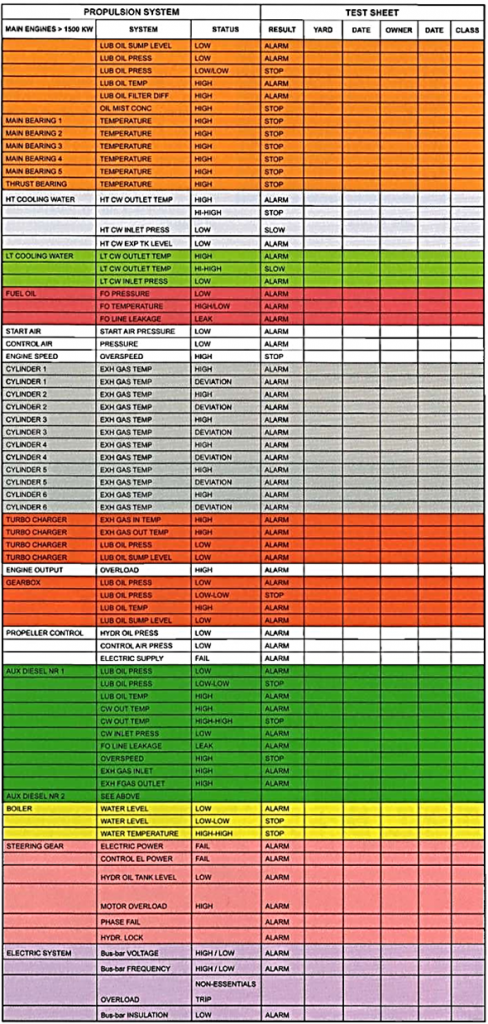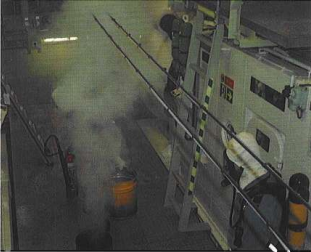Harbour Acceptance Tests (HAT)
Harbour Acceptance Tests (HAT)
After the equipment is installed onboard the ship and connected, Harbour Acceptance Tests are carried out to prove that the equipment is capable of functioning properly.
1. Electric power supply system tests
An example is the load tests of the diesel generator sets in combination with the switchboard. Load tests are often done using a water resistance device that consumes electrical power by heating water. A disadvantage of the device, is that it does not simulate the ship's load which is usually partially inductive. The power factor is 1 fora resistance load so that the maximum power for the diesel is reached at 80% current of the generator. This is therefore, not a generator test where current is the limiting factor.
Load steps also give a good idea of the generator set's performance. Auxiliary engine protection and shutdown systems are to be tested as well as automatic starting of standby pumps and sequential restart of essentials after a blackout.
Further tests may include the load dependent start-stop by a power management system with automatic reduction of propeller pitch and/ or RPM of electric driven thrusters in case of overload of the generator plant. Much of this testing can be done in harbour as it does not require the ship to be sailing.
2. Engine protection systems tests
Tests of safety stops for diesel generator engines, propulsion engines, boilers and likewise.
3. Automation system tests
Systems to be tested are the bridge control systems for main engines/ clutches/propellers, transfer from engine room to bridge, bridge to bridge-wing and back, emergency stops, thrusters' start-stop and controls and pitch and RPM indicators. This can all be done at reduced load along the quay.
Additional testing is required for steering gear systems' pump start/ stop with alarms, rudder position indicators, autopilots and propulsion safety systems, such as rudder limiters, interlocks between bowthruster and stabilizers.
The above tests have to be carried out prior to sea trials.
4. Fire protection
Safety systems such as fire detection, fire alarms, fire doors and shutters and fire fighting systems are to be tested before going on sea trials.
The fire detection in engine rooms consists of three types of sensors:
- Flame detectors
- Heat detectors.
During sea trials this test is repeated with engines and engine room ventilation running.
Smoke, heat and flametests
Realistic test of the smoke, heat and flame detection is done by burning diesel oil in a drum. Such tests are only carried out during sea trials to test the whole system. Adequate precautions as a fire extinguisher and people with fire resistent clothing is a must.
During normal operation smoke detection is carried out using a spray can with a special testing liquid on a broomstick. Flame detectors can be tested with a good torchlight, heat detectors with an ordinairy hair dryer.
5. Safety of people on board
Personal safety systems, such as internal communication, general alarm systems and public address systems have to be tested prior to leaving to sea.
Example of a safety checklist for main and auxiliary diesel engines


Smoke test in progress
6. Alarm and monitoring system tests
See the table above.
7. Emergency Power
Autostart of the emergency generator, the transitional source of power, emergency lighting, escape lighting, lifeboat preparation lighting and lights required to launch the boats, are to be tested.
8. External Communication
External communication systems must be tested and certified by or on behalf of the national authorities.
9. Nautical systems
Radars, gyrocompasses, echosounders, speed log, DGPS positioning reference systems and vertical reference units must be functionally tested so far as is possible during quayside testing.
10. Lighting
Functional tests of emergency lighting, navigation lighting, signal mast lighting and anchor lights also have to be carried out.
After successful completion of the HAT, the ship will receive a temporary certificate of seaworthiness by the authorities and is allowed to go to sea.Sea Acceptance Tests (SAT) complete the program by executing those tests which require sailing, including manoeuvring tests, stop tests and likewise. All these tests must be well documented with values, figures, in order to be available as a reference. Normally a booklet is produced by the shipyard with these data.
 +7 (812) 4-673-673
+7 (812) 4-673-673